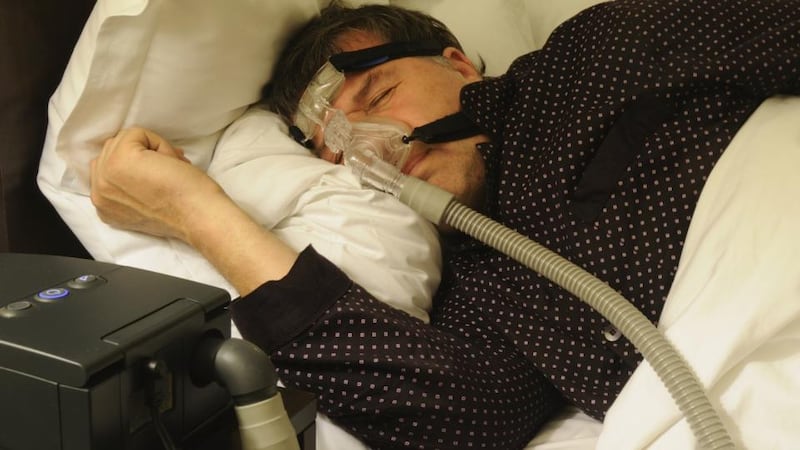Sleep apnoea is one of those conditions most people haven’t heard of unless they know someone who has been diagnosed with it and treated for it.
Even many GPs don’t have it at the top of their list of suspected conditions when patients complain of poor quality sleep and tiredness during the day.
As a result, respiratory specialists believe up to 90 per cent of sleep apnoea in adults and children goes undiagnosed. And it’s on the rise because obesity is a risk factor and, as we know, Irish people are getting fatter.

Dr Elaine Purcell at the Sleep Clinic in the Mater Private Hospital says sleep apnoea is often associated with overweight men but anyone can have it.
"Babies, children, teenagers and adults can have sleep apnoea. The overall incidence is one in 20 people but it is often missed in children and misdiagnosed in adults – particularly in post-menopausal women who are often considered to be depressed rather than checked out for sleep apnoea," she says.
Tiredness
The most obvious symptom of sleep apnoea is never feeling like you've had restorative sleep and, as a consequence, feeling tired during the day.
“Loud snoring followed by quiet spells are common symptoms, as are jumping, kicking or sweating in your sleep,” says Purcell.
Some sufferers will get morning headaches and go to the toilet a lot in the night.
Up to 50 per cent of adults with sleep apnoea will also have high blood pressure, according to Prof Walter McNicholas who runs the Sleep Clinic at St Vincent’s University Hospital, Dublin.
Sleep apnoea sufferers are at a higher risk of stroke, heart attack and diabetes. The condition runs in families, but being overweight and unfit are also causal factors.
In children, all the above are also risk factors to some extent but paediatric sleep apnoea is also much higher in children with genetic neuromuscular conditions. It can also be present in children with attention deficit hyperactive disorder (ADHD).
Some children have their tonsils or adenoids removed as a form of treatment while others wear sleep devices such as the CPAP worn by most adult sufferers.
When Maeve Walsh suffered from disturbed sleep beyond toddlerhood, her mother, Irene, began to look for an explanation.
“At four, she was still waking up distressed two to four times a night. She was always tired in the morning,” explains Walsh.
Results from a pulse oxyimetry found that Maeve, who has Down syndrome, was oxygen deprived in her sleep.
Unsettled
Following an operation to have her tonsils removed, Maeve was discharged from hospital but still unsettled at night.
About 14 months later, she was diagnosed with obstructive sleep apnoea following an overnight sleep study and has since been fitted with an airways pressure device.
“We’ve noticed a significant improvement in her mood, concentration and she has grown better. I think there needs to be much greater awareness of sleep apnoea,” explains Walsh.
Getting access to a sleep study (known as a polysomnography) to confirm diagnosis of sleep apnoea can be a problem.
"People can wait for over a year in all public hospitals in Ireland and these waiting lists have increased in the last six months as facilities have been reduced," says Dan Smith of the Irish Sleep Apnoea Trust, the support group for sleep apnoea sufferers and their families.
The long wait for diagnosis is, according to Smith, partly due to the absence of dedicated full-time sleep disorder specialists.
"A very busy respiratory consultant will spend about 20 per cent of his/her time on sleep disorder breathing. The Irish Sleep Society submitted a national sleep strategy to the HSE in August 2013 which was favourably received but awaits implementation," says Smith.
Treatment
Once diagnosed, sleep apnoea sufferers must adapt to wearing a dental device or one which pumps air into their nasal passages throughout the night.
“The treatment works well but some patients need a lot of encouragement to wear their devices in the beginning.
"Once they become more aware of the health consequences of untreated sleep apnoea – increased risk of heart attack, stroke, arrhythmias, high blood pressure, diabetes – that improves compliance greatly," says Purcell.
Link to health issues
Smith fervently believes that if respiratory sleep disorders such as sleep apnoea were fully diagnosed and treated, a lot of later life health problems wouldn't develop.
“Studies have shown reduced rates of stroke, decrease in high blood pressure, less likelihood of developing diabetes type 2 and glaucoma once sleep apnoea is treated,” he says.
“There are big financial savings in all of this too.”
Sleep
apnoea: the facts
Sleep
apnoea is a respiratory disorder which results in frequent short lapses in breathing throughout the night.
Obstructive sleep apnoea is the most common form. This is caused by the narrowing of the throat muscles to such an extent that breathing is stopped for 10-30 seconds. When this happens, the brain is immediately aroused to stimulate the throat muscles to re open to allow breathing.
What are the symptoms?
Restless sleep with a feeling of tiredness throughout the day; some sufferers of sleep apnoea snore, but not all snorers have sleep apnoea.
How is it diagnosed?
Diagnosis of the condition
follows
the sufferer undergoing an overnight sleep study (polysomnography) in a sleep clinic.
Portable devi ces can be used to check for signs of sleep apnoea but medical experts rely on respiratory data from a sleep clinic study for full diagnosis.
What is the treatment?
Sleep
apnoea is usually treated with a respiratory devi
ce
worn in bed every
night.
The Continuous Positive Airway Pressure (CPAP) devi ce is the most common ly used. Held on by a mask, the CPAP is linked by tubing to a small airway pressure devi ce which sends air into the lungs throughout the night.
Some people with mild sleep apnoea wear oral appliances.



















